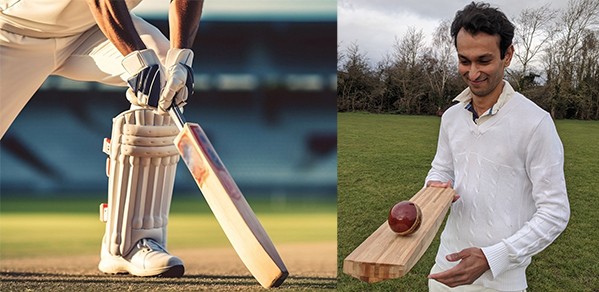
A new project involving Cambridge researchers aims to challenge existing “wasteful” practices in the design and production of cricket gear – and help preserve and grow the UK cottage industry supporting it.
The ultimate goal is to revive the manufacturing of cricket gear here in the UK, by relying less on imports from overseas, and using local materials, at a time where there is an increasing culture of repair.
Dr Darshil Shah
Funded by the Arts and Humanities Research Council (AHRC), and with the input and support of industry partners and social enterprise, the Design Accelerator project seeks to align the UK’s second-largest sport with net zero considerations by integrating circular design principles – reuse; repair; remanufacture; and recycle – into the product design and manufacture of cricket gear.
Led by the University for the Creative Arts (UCA), and in collaboration with Dr Darshil Shah, Associate Professor in Materials and Design at Cambridge, the project involves research into locally produced biomaterials, recycled materials and reused components for batting pads.
Batting pads are multi-component and multi-material and typically contain a mix of polyurethane, paperboard, cane, polyester mesh, high-density foam, thermoformed polystyrene, polyester lining and wadding (made of 50% cotton and 50% polyester). These materials, parts and components typically end up in landfill at the end of the product’s lifecycle and most are made from non-renewable sources.
The total carbon footprint of a pair of batting pads is equivalent to 2.60 CO2 eq. Kg/functional unit1 – similar to driving a distance of 10km – with, for example, 351,000 pairs of pads (552 tonnes) coming to the end of their first use life each year2. This is why sustainable alternatives are being sought in the form of biomaterials that are wholly or partially derived from plants, trees, or animals, as well as exploration of design changes to extend the useful life of the product.

Disassembly of cricket batting pads – components and materials. Credit: Dr Lilian Sanchez Moreno.
The hunt for alternative sustainable materials to develop, produce and test circular cricket batting pad prototypes is being led by Dr Shah from the Centre for Natural Material Innovation (CNMI) – a cross-disciplinary centre based in the Department of Architecture, University of Cambridge. Dr Shah also teaches at the Department of Engineering, where he supervises fourth-year MEng Engineering Tripos individual projects.
A keen cricketer and a former member of Thailand’s under-19 national cricket team, Dr Shah and his colleagues will use sustainable alternative materials identified in recent Cambridge research (e.g. synthetic chamois leathers for linings; waste fibres from banana leaf for fluffy fillings; and waste plastic materials for cane strips in pads) to develop four batting pad prototypes.
The project builds upon recent UCA research in partnership with Dr Shah, which was led by Professor Martin Charter and Dr Lilian Sanchez-Moreno (UCA), and the Centre for Sustainable Design (CfSD).
Dr Shah said: “Cricket is the most kit-intensive sport in the world. The production of cricket gear is characterised by wasteful e.g. linear and non-circular product lifecycles and currently features little repair and refurbishment, and limited reuse3, with much of the kit ending up in landfill. The manufacture of cricket gear is predominantly carried out in South Asia, thus increasing the embedded carbon of imported cricket gear.
“Our research has shown that there is huge potential for reusing different parts of these multi-material products, with a number of sustainable alternative materials to explore, many of which are plant-derived, and could be suitable for high-impact, resistant, rigid components such as batting pads.”

Word cloud illustrating qualities of leather that end-users feel need to be replicated in alternative leathers. Study led by Caitlin Mackellar.
Changing perceptions
Alumna Caitlin Mackellar, who graduated with a Master of Engineering (MEng) in 2023, conducted a user perception study of Cambridge student and staff attitudes to vegan leathers (made from plant-based or sustainable sources).
The study4 found prejudice/concerns about the “quality” and “durability” of bio-based alternative leathers, even though the end-users interviewed have never interacted with such leathers.
The purpose of the study was to understand what a major factor perception (e.g. from players, manufacturers and stakeholders) can play when it comes to confronting attitudes towards alternative sustainable materials in cricket.
“Notably, users had a generally poor understanding of the environmental impact of leather production and even those with knowledge did not avoid leather because of it,” said Dr Shah. “It was found that the reputation leather holds as a durable material often outweighs concern over impacts, and many participants justified purchases with the idea that the products will last significantly longer than an alternative.”
He added: “Based on systematic reviews and lifecycle assessment analyses, our work finds that fossil-fuel derived imitation leathers have significantly lower environmental impact than bovine leathers, and a slightly higher but not vastly dissimilar environmental impact in comparison to sustainable/bio-based alternative leathers.
“It is also worth mentioning, for context, that cricket governing bodies are turning their attentions to sustainability and widening access to the sport, for example, by hiring for sustainability and accessibility posts. And in 2023, the England and Wales Cricket Board (ECB) published its first Impact of Cricket report, in which it presented a strategy for “promoting environmental sustainability”.”

An Ashby plot produced to show the range of materials used in conventional cricket gear. Credit: Ansys CES EduPack (2023).
Untapped potential of a cottage industry
“Design and material innovation of cricket gear is critical if the sport is to improve its reach and sustainability,” said Dr Shah. “As an established cottage industry, there remain conservative attitudes towards innovation within cricket that have contributed to the preservation of traditional materials.
“These multi-component products are hand produced. For example, it can take a worker one day to make two pairs of cricket gloves. But this time-intensive level of craftsmanship in the UK is under increasing threat, with the heritage craft of cricket ball making now extinct in the UK. Through this Design Accelerator project, we hope to preserve the skillset of stitching/sewing cricket gear here in the UK by training up a workforce for the making, repair and refurbishment of prototype batting pads.
“The ultimate goal is to revive the manufacturing of cricket gear here in the UK, by relying less on imports from overseas, and using local materials, at a time where there is an increasing culture of repair, as more people choose to make steps towards a more sustainable future.”

Tensile testing of alternative leathers – banana leaf, tree bark, waste fish scales and pineapple leaf. Credit: Beth Taylor.
Vegan leathers for cricket balls and gloves
Alumna Beth Taylor, who graduated with a Master of Engineering (MEng) in 2023, conducted preliminary research into the application of sustainable biomaterial leather alternatives to cricket balls and gloves, having consulted the British Standards to define desired parameters.
Beth completed a review of all companies that are currently researching potentially appropriate materials and tested some of these materials in the Department of Engineering and the Department of Chemistry. This included tensile testing, abrasion testing, ‘stitchability’ and seam strength, as well as water droplet behaviour (such as absorption).
The project tested five material groups: abaca banana leaf fibres; tree bark fibres; reconstituted proteins from waste fish; pineapple leaf fibres; and bovine leather (industry trademark). The most important properties under consideration were thickness, tensile strength, stitchability, abrasion resistance, and interaction with water.
The findings showed that whilst some of the alternative leathers tested showed potential – for example, abaca banana leaf fibres came close to ball leather in terms of strength but had inadequate extensibility – their performance was not on par with bovine leathers for cricket gear applications.
Among the recommendations for future work is further higher-level collaboration between cricket gear manufacturers, academics and biotechnology companies to accelerate progress in this area.
Developing circular batting pads of the future
It is intended that the circular batting pad prototypes, developed under the Design Accelerator project, will be technically tested by professional players. Further still, this work will be completed through collaboration with a social enterprise to develop a new, UK-based production model, which lessens the environmental impact, while contributing to reducing social inequalities. This will involve the training of a volunteer workforce to make, repair and refurbish batting pads.
---
1 Dr Lilian Sanchez Moreno and Professor Martin Charter. Final Report – Streamlined Life Cycle Assessment: Pair of Cricket Batting Pads. The Centre for Sustainable Design, 2023.
2 Professor Martin Charter and Tom Clark. Final Report – Sustainability, Cricket Gear, Clothing and Apparel: Report on Cricket Gear. The Centre for Sustainable Design, 2022.
3 Joanna Czutkowna and Martin Charter. Final Report – 3Rs: Reuse, Repair, Refurbishment and Resale Report on Cricket Gear. The Centre for Sustainable Design, 2023.
4 These perception studies were conducted through 17 in-depth object-based interviews, each lasting 25 minutes.

